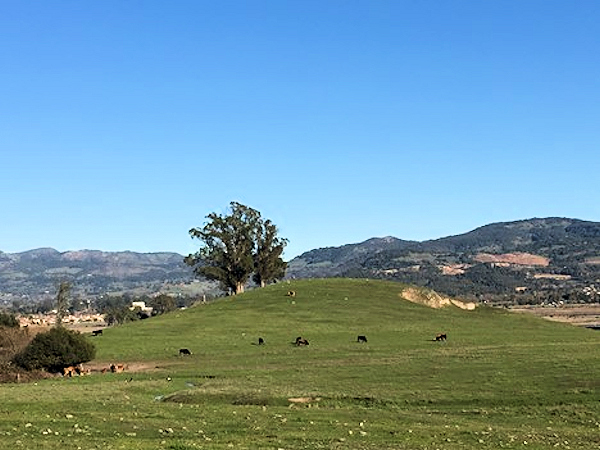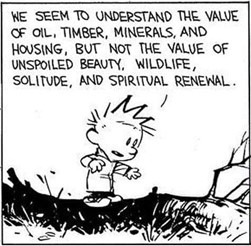They paved paradise and put up a parking lot
With a pink hotel, a boutique, and a swinging hot spot
Don't it always seem to go
That you don't know what you got 'til it's gone
They paved paradise and put up a parking lot
Joni Mitchell
 The south-west approach to Napa is famous for the “Oreo” cows that graze the hillsides. Right next door, at the Ghisletta Ranch, Longhorns do the same; but perhaps not for long. In a misguided and misplaced effort to increase housing in Napa, the city proposes to annex this county land and authorize the construction of up to 3000 housing units with some 7000 residents. That is a population equivalent to St. Helena on less than 150 acres of land. Despoiled open space, that is. (Photo credit: by Chris Robbins)
The south-west approach to Napa is famous for the “Oreo” cows that graze the hillsides. Right next door, at the Ghisletta Ranch, Longhorns do the same; but perhaps not for long. In a misguided and misplaced effort to increase housing in Napa, the city proposes to annex this county land and authorize the construction of up to 3000 housing units with some 7000 residents. That is a population equivalent to St. Helena on less than 150 acres of land. Despoiled open space, that is. (Photo credit: by Chris Robbins)
The plans for the Ghisletta property[1] are revealed in the draft Land Use Element of the Napa’s new General Plan, which is in final development stages. The idea to annex and develop these properties is not new and, in a somewhat different form, is part of the city’s current General Plan which dates from the late 1990s. That the idea has been around for so long has led some to claim that development of the site is a foregone conclusion.[2] Nevertheless a bad idea remains a bad idea no matter how long it has been under consideration.
What are the rationales for Napa wanting to see development at the Ghisletta ranch? There are two principal ones and they are interrelated. First, Napa faces a state mandate to construct nearly 3000 housing units over the next eight-year cycle beginning in 2023. These mandates are referred to as the Regional Housing Needs Allocation (RHNA) numbers. Second, Napa’s inventory of affordable and low-income housing is woefully inadequate. Build affordable housing at the Ghisletta ranch and kill two birds with one stone.
Why then is development of the Ghisletta Ranch, nonetheless, a bad idea?
On a broad level, these developments, which are anticipated in the city’s draft Land Use Element of the General Plan, are in direct conflict with the guiding principles that are meant to inform that plan. These, taken directly from the plan are:
- Sustainability and open space preservation
- Mixed use development and infill along commercial corridors
- Diversity of housing types
- Protection from natural hazards
- Walking/biking connectivity
Development of the Ghisletta properties does nothing to advance these goals; it directly contradicts them. There are at least nine specific objections to building on the Ghisletta properties.
- Urban Spawl. The parcels under consideration are agricultural lands that lie in the county, not in the city[3]. Building here is the very definition of urban sprawl. Community surveys conducted in conjunction with the development of the land use element showed that over 77% of Napans oppose converting agricultural land to housing.
- High Development and Servicing Costs. The city must provide expensive infrastructure to and development of these properties and will need to provide new police and fire services to any residents there. The Public Policy Institute of California has demonstrated that, in this state, revenues generated by residential property taxes do not cover the costs of providing city services. This is likely the reason for the inclusion of a mixed-use element: to generate revenue from sales taxes.
- Natural Hazards. The west Napa earthquake fault runs directly through the properties. The fault line setbacks required, coupled with the flood zone areas of the property vastly reduce the amount of land that actually is available for development. This means fewer housing lots and higher priced homes.
- Vanishing Viewsheds. Development of these properties will dramatically affect the viewshed that provides a welcome to the Napa Valley.
- Pollution. Development of these parcels will bring a huge number of cars and trucks into this area greatly increasing air pollution and contributing to increased congestion on narrow city roads.
- Wildfires. The current open space provides a wildfire buffer for the city. The salutary lessons of Coffey Park in Santa Rosa ought not be forgotten.
- Parks. There are NO city parks in south-west Napa. Preserving open space is vital for the overall health of the community.
- Carbon Capture. Grasslands are important carbon sinks. Grasslands are known to be effective carbon sinks that, in our current climate conditions, extract and store more atmospheric carbon than young forests. Grassland store carbon in the roots and do not release this carbon into the air when wildfires strike. Development of these properties would replace a productive and active carbon sink with a congested heat island.
- Water. Where will it come from? Napa currently consumes approximately 14,000 acre-feet of water per year. Water is our most precious resource. Clearly there is a major conflict between the state mandate to increase housing availability in our area and the state mandate to ensure sustainability of our water resources. Together with the more than 900 dwellings and commercial uses planned for Napa Pipe, this development puts enormous strain on our capacity to ensure water for all Napans. The proposed developments represent a 13% increase in the population of Napa yet our available water supply is diminishing exponentially. Deliveries from the State Water Project are now minimal, the water level at Lake Hennessy is dropping and the potential for long term drought is increasing.
But doesn’t the clear and obvious need for affordable housing trump all of these considerations? The straight forward answer is no; building affordable housing on the Gateway Parcels, is a bad idea even if it were environmentally and financially feasible. This development would create a virtual affordable housing “ghetto” lumping large numbers of disadvantaged far from the city center and job sites thereby ensuring marginalization and underscoring their disadvantages from the rest of Napa. Affordable Housing - ALL Housing - should be inclusive, integrated housing. The affordable housing issue is simply a “Red Herring”.
Urban sprawl, environmental degradation and pollution. Perhaps Calvin summarizes it best of all:

[1] For ease of use, I refer to the properties in question as the Ghisletta ranch. The “ranch” is comprised of several parcels, including a substantial on belonging to the Napa Horseman’s Association. The Horseman parcel is at the norther extremity of the area designated for annexation.
[2] For example, at a recent meeting of the Napa Housing Coalition, Vin Smith, Napa’s Community Development director and the person in charge of planning for the city, went on record as stating, categorically, that the development will occur.
[3] Although outside the city limits, these properties are within the city sphere of influence and inside the existing RUL.